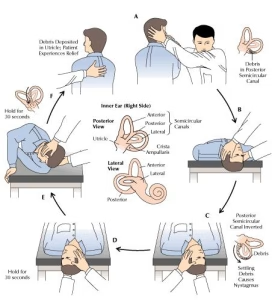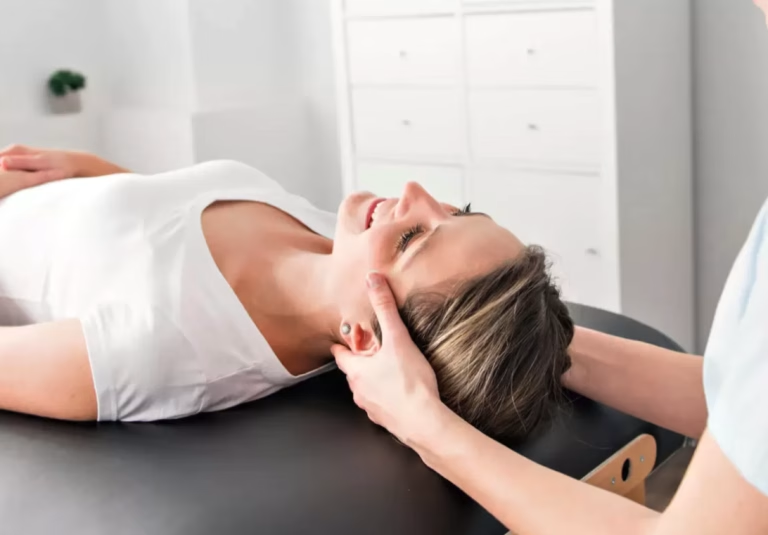Benign Paroxysmal Positional Vertigo (BPPV) Treatment at Blue Maya Physio Clinic
Struggling with BPPV symptoms like dizziness or vertigo? At Blue Maya Physio Clinic, our expert vestibular physiotherapists offer effective physiotherapy for BPPV, using techniques like the Epley Manoeuvre to relieve discomfort and restore balance. Whether you experience vertigo when turning your head or dizziness when lying down, we’re here to help you regain control.
What is Benign Paroxysmal Positional Vertigo (BPPV)?
BPPV is a common inner ear condition that affects the vestibular system—a network of fluid-filled canals that help your brain understand your head’s position. Sometimes, tiny crystals called otoconia dislodge from the inner ear and float into these canals. When you move your head, the fluid shifts unnecessarily, sending false signals to your brain. This causes involuntary eye movements (nystagmus) and a spinning sensation known as vertigo, even when you’re still.
Here’s what BPPV stands for:
- Benign: Not cancerous or life-threatening.
- Paroxysmal: Sudden, recurring episodes.
- Positional: Triggered by specific head positions.
- Vertigo: A dizzy, spinning feeling.
BPPV often strikes when you turn over in bed, look up, or shift your head quickly. While it’s the most common cause of vertigo—especially in people over 40—it’s usually not serious. Although BPPV may resolve on its own, physiotherapy for vertigo can speed up recovery and prevent future episodes. At Blue Maya Physio Clinic, our specialists provide comprehensive assessments and personalised treatments to get you back to normal.
What Causes BPPV?
The exact cause of BPPV isn’t always clear, but it’s more common as we age. Other potential triggers include:
- Ear injuries
- Ear infections or viruses
- Head injuries
- Gender: Women are more prone to BPPV than men
Our physiotherapists at Blue Maya Physio Clinic will explore your history to identify possible causes and customize your treatment plan.
Symptoms of BPPV
BPPV symptoms can vary depending on how severe the condition is. Common signs include:
- Spinning sensation (vertigo)
- Nausea or vomiting
- Dizziness when moving your head (e.g., looking up, down, or turning)
- Involuntary eye movements (nystagmus)
- Headaches
- Balance issues when standing or walking
If you notice vertigo when lying down or dizziness when turning your head, it’s time to seek help. Our team will assess your symptoms and design a tailored program to minimise them.
How is BPPV Diagnosed?
At Blue Maya Physio Clinic, our physiotherapists start with a detailed history of your symptoms, followed by a full vestibular examination. We use specialized positional tests—such as lying you down on a table with your head turned—to confirm BPPV. These tests might briefly trigger your symptoms, which can feel unpleasant, but they’re critical for pinpointing the problem and planning effective BPPV treatment.

Image source: https://www.cancertherapyadvisor.com/home/decision-support-in-medicine/hospital-medicine/benign-paroxysmal-positional-vertigo-benign-paroxysmal-nystagmus/
How Can Physiotherapy Help with BPPV?
Physiotherapy is a proven way to treat BPPV by repositioning the misplaced crystals in your inner ear. Our specialists use targeted techniques to move the otoconia out of the canals where they cause vertigo, relieving your symptoms. We also provide guidance on managing BPPV and preventing it from coming back.

Physiotherapy Treatments for BPPV
Your treatment at Blue Maya Physio Clinic will be personalized based on your symptoms and the severity of your BPPV. Our evidence-based techniques include:
- Epley Manoeuvre: A series of four precise head movements to shift the crystals to a harmless location in your inner ear.
- Semont Manoeuvre: Quick movements from lying on one side to the other to dislodge the crystals.
- Home exercise program: Simple exercises to mobilize the crystals and maintain relief.
- Balance retraining exercises: Strengthen stability and reduce fall risk.
- Neck mobilizations: Ease any related neck stiffness.
- Education: Tips to manage BPPV and avoid triggers.
We adjust your plan as your symptoms improve, ensuring it’s always suited to your needs.
Frequently Asked Questions About BPPV
What triggers BPPV?
BPPV is often triggered by head movements like rolling over in bed, looking up, or bending down. It can also stem from ear injuries, infections, or head trauma.
How long does BPPV last?
Episodes typically last less than a minute, but they can recur for weeks or months without treatment. Physiotherapy can shorten this timeline.
Is BPPV dangerous?
No, BPPV isn’t life-threatening, but it can lead to falls if balance is affected. Early intervention keeps you safe.
Can I treat BPPV at home?
While some try the Epley Manoeuvre at home, professional physiotherapy ensures it’s done correctly and safely.
Why choose Blue Maya Physio Clinic for BPPV?
Our vestibular physiotherapists are highly trained in techniques like the Epley and Semont Manoeuvres, offering personalised care for lasting relief.
Don’t let BPPV hold you back. Our skilled physiotherapists at Blue Maya Physio Clinic can eliminate your vertigo and restore your balance with expert treatments like the Epley Manoeuvre. Book an appointment today or call us to start feeling better!
